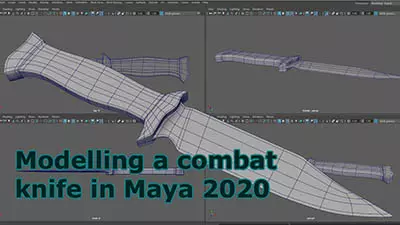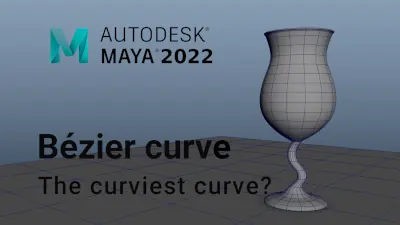Integrating 3D models with photography
Interested in integrating your 3D work with the real world? This might help
#
1
30-09-2006
, 02:01 AM
Creating equidistant objects on a curve
Let's say I have a guide curve (e.g. the letter S) flat on the plane.
And let's say that I want to create multiple equidistant spheres on the guide curve. How can I go about doing it?
Real life example: Hand rails on a ship.
#
2
30-09-2006
, 03:05 AM
Accept no substitutions.
#
3
30-09-2006
, 03:34 AM
#
4
07-10-2006
, 09:27 AM
1. On the Time Slider, set the time to go from 1 to (let's say) 200.
2. Createa vertical railing (aka NURBs cylinders).
3. Draw a curve to represent where you want the railings to run.
4. Select the railing & the curve, go to Animate -> Motion Paths -> Attach to Motion Path.
5. With the railing selected, go to Animate-> Create Animation-> Snapshot ->options.
6. Set the Time Range to Time Slider and Increment to whatever value (let's say 5).
7. Hit the Snapshot button.
8. There will be railings creating now on the curve at almost equidistant.
#
5
07-10-2006
, 02:35 PM
also cant u dup along a curve an just set the increments apart
Now at SMU doing BSc 3D Computer Animation so its hard to get on here
My wire render tut https://forum.simplymaya.com/showthre...threadid=20973
#
6
07-10-2006
, 05:52 PM
Registered User
Join Date: Aug 2004
Join Date: Aug 2004
Posts: 408
Yea -- creating objects along animation curves is the easy way... but anyone who took calculus knows that it may or may not create equidistant objects depending on velocity down the motion path.Originally posted by parka
Ok, I think I found a much faster solution.
1. On the Time Slider, set the time to go from 1 to (let's say) 200.
2. Createa vertical railing (aka NURBs cylinders).
3. Draw a curve to represent where you want the railings to run.
4. Select the railing & the curve, go to Animate -> Motion Paths -> Attach to Motion Path.
5. With the railing selected, go to Animate-> Create Animation-> Snapshot ->options.
6. Set the Time Range to Time Slider and Increment to whatever value (let's say 5).
7. Hit the Snapshot button.
8. There will be railings creating now on the curve at almost equidistant.
Though you will only really get non-constant velocities down motion paths if you *deliberately* alter the speeds. Maya last I checked assumes constant velocities.
#
7
07-10-2006
, 05:55 PM
man that its a hard subject
Now at SMU doing BSc 3D Computer Animation so its hard to get on here
My wire render tut https://forum.simplymaya.com/showthre...threadid=20973
#
8
17-10-2006
, 11:37 AM
Draw your curve and change the string value in my script to the same as your curve name:
then run this:
int $numb = 100;
float $i = 0.0;
//change this to your curve name
string $crv = "curve1";
//make sure your curve is rebuilt to be between 0 and 1
rebuildCurve -ch 1 -rpo 1 -rt 0 -end 1 -kr 0 -kcp 0 -kep 1 -kt 1 -s 20 -d 3 -tol 0 $crv;
for($i; $i <= $numb; $i++)
{
float $inc = (1.0/$numb) * $i;
float $pos[] = `pointOnCurve -pr $inc $crv`;
sphere;
xform -ws -t $pos[0] $pos[1] $pos[2];
}

A
#
9
17-10-2006
, 01:51 PM
head spinning...
*dies*
Accept no substitutions.
Posting Rules Forum Rules
Similar Threads
Question about creating objects
by thewrongvine in forum Maya Basics & Newbie Lounge replies 7 on 20-08-2013
creating geometry on a curve
by kimsay in forum Maya Basics & Newbie Lounge replies 3 on 23-09-2009
creating pipe from curve??
by kavelle in forum Maya Basics & Newbie Lounge replies 3 on 24-07-2006
creating surface with non-flat closed curve
by lemonaded in forum Maya Basics & Newbie Lounge replies 7 on 02-11-2003
fur rendering failed?????
by olivermagno in forum Maya Materials & Textures replies 2 on 21-05-2003
Topics
Free Courses
Full Courses
VFX News
How computer animation was used 30 years ago to make a Roger Rabbit short
On 2022-07-18 14:30:13
Sneak peek at Houdini 19.5
On 2022-07-18 14:17:59
VFX Breakdown The Man Who Fell To Earth
On 2022-07-15 13:14:36
Resident Evil - Teaser Trailer
On 2022-05-13 13:52:25
New cloud modeling nodes for Bifrost
On 2022-05-02 20:24:13
MPC Showreel 2022
On 2022-04-13 16:02:13












